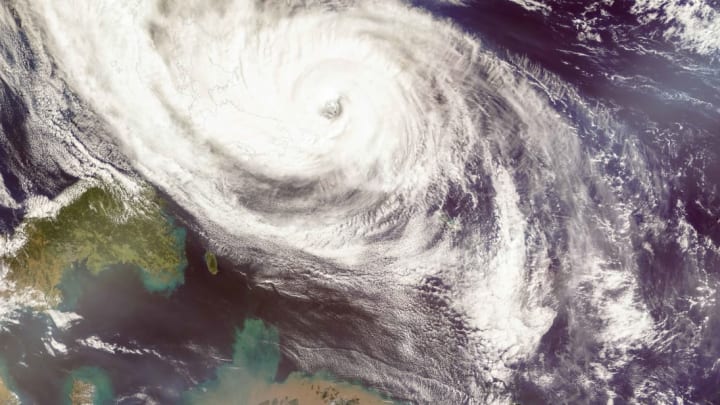Most of us have seen at least one extreme weather event in our lives. But no matter how things look from the ground, these events look drastically different, even surprisingly peaceful, from above. Here are some of the biggest weather events of the last few decades, as seen from space.
1. Hurricane Katrina
Most of us remember the severe devastation Hurricane Katrina (top image) caused, and it’s easy to see why the storm presented so many problems when seen from above—the arms of the hurricane expanded across most of the Gulf of Mexico. When this image was taken on August 28, 2005, winds in the storm were recorded traveling at about 160 mph.
Katrina was not only one of the five deadliest hurricanes in U.S. history—it was also the most expensive natural disaster in the country's history, causing more than $108 billion in damages.
2. Superstorm Sandy

Just last year, the Floss headquarters was closed for weeks thanks to this massive hurricane that caused over $75 billion in damage.
3. Ireland and Britain’s Winter of 2009-2010

While not due to one storm in particular, the winter of 2009 through 2010 was unusually cold throughout Europe, earning the season the title of “The Big Freeze.” This satellite image from January 7, 2010 shows the extent of snow covering over England and Scotland.
4. Snowmageddon

Europe wasn’t the only area hit hard by winter that season. On February 5, 2010, the North Atlantic coast was hit by a category 3 (major) blizzard. Up to 35 inches of snow was dropped on the East Coast of the U.S. The area was already suffering from the effects of a blizzard that had occurred in December, and when another category 3 blizzard happened only a few days later, bringing another 20 inches of snow, the media began pronouncing the event “snowpocalypse,” “snoverkill” and “snowmageggon.” Catchy nicknames aside, the storms resulted in the snowiest winter on record for much of the Mid-Atlantic, which is easy to imagine given how much snow is visible in this satellite image taken on February 11.
5. Cyclone Gafilo

While it might not be as famous as many of the other storms on this list, 2004’s Cyclone Gafilo is the most intense cyclone to ever form in the south-western Indian Ocean and the strongest cyclone to strike Madagascar. With winds reaching over 185 miles per hour, the storm caused more than $250 million in damages and resulted in 172 deaths.
This image shows the cyclone on March 6, after it reached peak speed and was about to strike northwest Madagascar.
6. 2009's Australian Sandstorm

When someone says “extreme weather,” you probably think of wet conditions, but when high winds hit sand, they can result in massive dust storms that can be just as intense as a blizzard. In September of 2009, a dust storm hit Eastern Australia, sweeping dirt and debris across New South Wales and Queensland. Typically, air particle concentrations register at 20 micrograms per cubic meter of air. During bushfires, the air particle concentration raises to about 500 micrograms per cubic meter. So you can imagine how concentrated the dust must have been for the air concentration levels to reach 15,400 during the storm. It’s been estimated that the storm carried over 16 million tons of dust from the desert to the coast, at a peak level of 75,000 tons per hour.
7. 2003 Firestorm

Many would hesitate to call wildfires a weather event, but in most cases, weather is at least partially responsible. This was definitely the case in the California wildfires of October 2003, where over 15 wildfires broke out throughout Southern California and Baja, Mexico. I was in San Diego when the fires first broke out and there was so much thick, white ash in the air that even 20 miles from the fires, it looked like the roads were covered in snow.
8. 2007 Wildfires

I was also present for the 2007 California wildfires, which were a result of many of the same weather conditions as the 2003 fires, which have become a seasonal problem for the region.
Were any of you witness to these events, or do you have any extreme weather stories of your own? While everyone loves a good story, you might consider yourself lucky if your answer is “no” this time.
